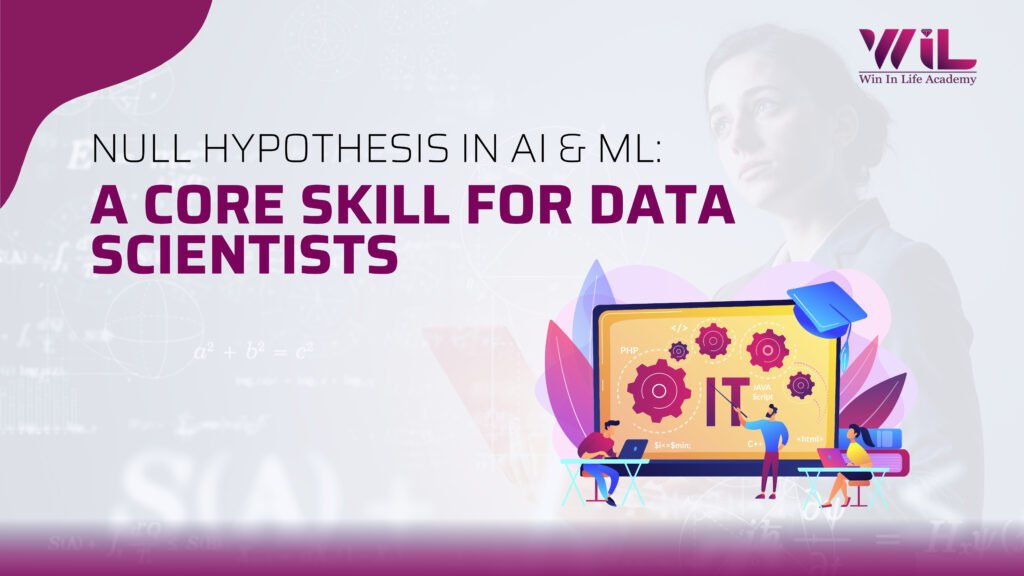In Artificial Intelligence and Machine Learning, we often find ourselves captivated by the algorithms, vast datasets, and the vast predictions our models can make. We spend countless hours fine-tuning hyperparameters, exploring new architectures, and pushing the boundaries of what machines can learn. But amidst all this excitement, there’s a foundational concept, often lurking in the shadows, that silently underpins the very credibility of our work: the null hypothesis.
For anyone embarking on a PG Diploma in AI and ML, understanding the null hypothesis isn’t just an academic exercise; it’s a crucial skill that transforms you from a model-builder into a trustworthy data scientist. It’s the lens through which we scrutinize our assumptions, validate our findings, and confidently declare whether our latest model improvement is truly meaningful or just a fluke.
Enroll Now: PG Diploma in AI and ML
What is the Null Hypothesis?
At its core, the null hypothesis (H0) is a statement of no effect, no difference, or no relationship. Think of it as the default assumption. It’s the scientific equivalent of “innocent until proven guilty.” When we conduct an experiment or build a model, we’re often looking for something new with better performance, a significant impact, and novel discovery. The null hypothesis, conversely, assumes that nothing new or significant is happening.
Let’s ground this up with an example. Imagine you’ve developed a new recommendation algorithm for an e-commerce platform. Your gut feeling, and perhaps some preliminary tests, suggest it’s superior to the old one. The null hypothesis, in this scenario, would state:
H0: There is no significant difference in user engagement (e.g., click-through rate) between the new recommendation algorithm and the old one.
This might feel counterintuitive. Why would we assume no difference when we’re trying to prove a difference? The genius of this approach lies in its rigor. Instead of trying to directly prove our new algorithm is better, we try to disprove the idea that it’s not better. If we can gather enough evidence to strongly reject the null hypothesis, then, and only then, can we confidently assert that our new algorithm likely has a positive effect.
The alternative hypothesis (H1 or Ha), on the other hand, is what we hope to demonstrate. In our recommendation engine example, the alternative hypothesis would be:
H1: The new recommendation algorithm leads to significantly higher user engagement compared to the old one.
Our entire statistical endeavor, from designing experiments to interpreting p-values, revolves around this dance between null and alternative hypotheses.
The Applied Significance of Hypothesis Testing in AI/ML

You might be thinking, “This sounds like pure statistics. How does it apply to my AI/ML journey? The answer is: profoundly. Every time you evaluate a model, compare two algorithms, or even decide if a feature truly contributes to your model’s predictive power, you are implicitly (or explicitly) engaging in Hypothesis Testing in Data Science.
Consider these real-world scenarios in AI and ML:
- Is my new deep learning model truly better than the previous one?
- Does adding this new feature significantly improve the accuracy of my sentiment analysis model?
- Is there a visible difference in the performance of my fraud detection algorithm between two different customer segments?
- Are the results of my A/B test on a new UI element for my AI-powered app statistically significant?
In each of these cases, the null hypothesis provides the baseline for comparison. It’s the standard against which we measure our observations. Without it, our conclusions would be mere conjecture, lacking the statistical backing that transforms good ideas into verifiable insights.
Statistical Landscape: Significance, P-Values, and Error Types
Once we establish our null and alternative hypotheses, the next step is to gather data and perform a statistical test. This is where concepts like Statistical Significance in Machine Learning come into play.
The P-Value
After running a statistical test, we typically arrive at a p-value. The p-value (probability value) is the probability of observing our data (or more extreme data) if the null hypothesis were true.
Let’s re-read that carefully: “if the null hypothesis were true.” A small p-value suggests that our observed data would be very unlikely if there were no real effect. Therefore, a small p-value provides strong evidence against the null hypothesis.
Conventionally, we set a significance level, denoted by alpha (α), often at 0.05 (or 5%). This means we are willing to accept a 5% chance of making a Type I error (more on that in a moment).
- If P-value ≤α: We reject the null hypothesis. This implies that the observed effect is statistically significant, meaning it’s unlikely to have occurred by chance.
- If P-value >α: We fail to reject the null hypothesis. This means we don’t have enough evidence to conclude that a significant effect exists. It doesn’t mean the null hypothesis is true; it just means we couldn’t disprove it with the available data.
Type I and Type II Errors
No statistical test is foolproof. There’s always a risk of making an incorrect decision. Understanding these errors is paramount for responsible data science.
- Type I Error (False Positive, Alpha Error): This occurs when we reject a true null hypothesis. In our recommendation algorithm example, it would mean concluding the new algorithm is better when, in reality, it offers no significant improvement. The probability of making a Type I error is α (our significance level). We want to minimize this, as it can lead to wasted resources or misguided strategies based on false positives.
- Type II Error (False Negative, Beta Error): This occurs when we fail to reject a false null hypothesis. In our example, it would mean concluding the new algorithm is not better when, in reality, it is genuinely superior. The probability of making a Type II error is β. This error can lead to missed opportunities or failing to adopt a truly beneficial solution.
The trade-off between Type I and Type II errors is crucial. Reducing the chance of a Type I error (e.g., by lowering α to 0.01) increases the chance of a Type II error, and vice versa. The optimal balance depends on the specific context and the consequences of each type of error. For instance, in medical diagnostics, a Type I error (false positive for a disease) might lead to unnecessary treatment, while a Type II error (false negative) could delay crucial intervention.
Operationalizing Null Hypothesis Principles in AI & ML Workflows

Now, let’s dive into how the null hypothesis and Hypothesis Testing in Data Science are not just theoretical constructs but indispensable tools in your AI/ML toolkit.
1. Model Performance Evaluation (Statistical Methods)
You’ve trained a shiny new classification model. Its accuracy on the test set is 92%. Your previous model had 90%. Is 2% improvement really an improvement, or just random variation? This is where the null hypothesis steps in for robust Model Performance Evaluation (Statistical Methods).
You could set up a null hypothesis like:
H0: There is no significant difference in the F1 score (or accuracy, precision, recall) between the new model and the old model.
To test this, you might use statistical tests like:
- Paired t-test: If you’re comparing the performance of two models on the same set of data points (e.g., predictions on the same test set).
- McNemar’s test: Specifically for comparing two classifiers on the same dataset, focusing on their misclassifications.
- Bootstrapping: A non-parametric method where you resample your data multiple times to create a distribution of performance metrics and then assess the difference.
By applying these methods, you gain the statistical confidence to declare whether your model’s improved performance is genuinely significant or just noise. This is vital when presenting your work or making data-driven decisions about model deployment.
2. Feature Selection
Imagine you have a dataset with hundreds of features for a regression task. You suspect some features are redundant or even detrimental. How do you statistically validate the impact of dropping or adding a feature?
The null hypothesis can help:
H0: Adding feature X does not significantly improve the predictive power (e.g., R-squared, RMSE) of the model.
You could compare models with and without the feature using statistical tests or by observing changes in model performance metrics and their statistical significance. Techniques like Recursive Feature Elimination (RFE) often implicitly rely on such assessments to iteratively select optimal features.
3. Hyperparameter Tuning
You’ve run a grid search and found a new set of hyperparameters that yields a slightly better validation score. Is this a real gain or just a random chance from hyperparameter space exploration?
Again, formulate your null hypothesis:
H0: There is no significant difference in model performance (e.g., cross-validation score) between hyperparameter set A and hyperparameter set B.
Statistical tests on the cross-validation folds (e.g., comparing mean scores and their variances) can provide the necessary evidence to accept or reject this null hypothesis.
4. A/B Testing for AI Models
Perhaps one of the most direct and impactful applications of the null hypothesis in the AI/ML world is A/B Testing for AI Models. This is crucial when you want to compare a new version of your AI-powered system (Model B) against the currently deployed one (Model A) in a live environment.
Let’s say you’ve developed a new search ranking algorithm. You want to see if it leads to more clicks or conversions. You deploy Model A to 50% of your users and Model B to the other 50% (randomly assigned, of course).
The null hypothesis for your A/B test would be:
H0: There is no significant difference in the conversion rate (or relevant metric) between users exposed to Model A and users exposed to Model B.
You then collect data for a predetermined period and perform a statistical test (e.g., a z-test or chi-squared test for proportions, or a t-test for means, depending on your metric).
If your p-value is below your chosen α (e.g., 0.05), you reject the null hypothesis and conclude that Model B is significantly better (or worse!) than Model A. This provides a data-driven, statistically sound basis for deciding whether to roll out Model B to all users. Without rigorous A/B testing grounded in hypothesis testing principles, deployment decisions are often based on intuition or limited offline metrics, which can be misleading.
The Imperative of Statistical Validation
The null hypothesis isn’t just a statistical tool; it embodies a philosophy of scientific rigor and skepticism. It forces us to ask: “What if I’m wrong? What if there’s nothing new here? This self-critical approach is what separates robust scientific inquiry from mere conjecture.
In the rapidly evolving field of AI and ML, where models can become incredibly complex and their internal workings sometimes obscure, the null hypothesis provides a crucial anchor. It ensures that our claims about model superiority, feature importance, or algorithmic impact are not just based on observed numbers, but on statistically validated evidence.
Avoiding the P-Hacking Trap
A word of caution: the allure of statistical significance can sometimes lead to “p-hacking” – manipulating data or statistical tests to achieve a desired p-value. This undermines the integrity of your work. Always formulate your hypotheses before data collection and analysis and adhere to sound statistical practices. Remember, failing to reject the null hypothesis isn’t a failure; it’s an honest scientific finding that prevents you from chasing phantom effects.
Best Practices for AI & ML Practitioners

As you progress through your PG Diploma in AI and ML, make it a habit to explicitly formulate your null and alternative hypotheses for any experiment or model comparison you undertake. Here are some tips:
- Be Specific: Don’t just say “My model is better.” Specify how it’s better (e.g., “significantly higher F1-score,” “lower RMSE”).
- Define Your Metric: Clearly state the performance metrics you are using for comparison (accuracy, precision, recall, F1-score, RMSE, MAE, conversion rate, click-through rate, etc.).
- Identify Your Comparison Groups: Are you comparing two models, a model with and without a feature, or two user segments?
- Choose Your Significance Level (α): This is typically 0.05 but can be adjusted based on the context and the cost of Type I vs. Type II errors.
- Consider the Practical Significance: Even if a result is statistically significant, is it practically significant? A 0.1% improvement in accuracy might be statistically significant with a huge dataset, but practically insignificant for deployment. Always consider both.
Final Thoughts
The null hypothesis, far from being a dry statistical concept, is a dynamic and essential component of modern AI and Machine Learning. It’s the silent guardian of statistical integrity, ensuring that our claims about model performance, feature impact, and algorithmic superiority are grounded in evidence, not just intuition.
By mastering Hypothesis Testing in Data Science, understanding Statistical Significance in Machine Learning, and expertly applying these principles to tasks like A/B Testing for AI Models and robust Model Performance Evaluation (Statistical Methods), you elevate your capabilities from a mere practitioner to a truly insightful and credible data scientist. You’ll be equipped to not only build powerful AI models but also to critically evaluate their effectiveness and confidently communicate their true impact.
Ready to transform your understanding of AI and Machine Learning from theory to impactful, validated practice?
Explore advanced programs and specialized courses in AI and Machine Learning that integrate rigorous statistical validation and practical application. Visit Win in Life Academy today and take the next significant step in your data science journey.
References
Null Hypothesis: What Is It, and How Is It Used in Investing?
https://www.investopedia.com/terms/n/null_hypothesis.asp
Null Hypothesis





